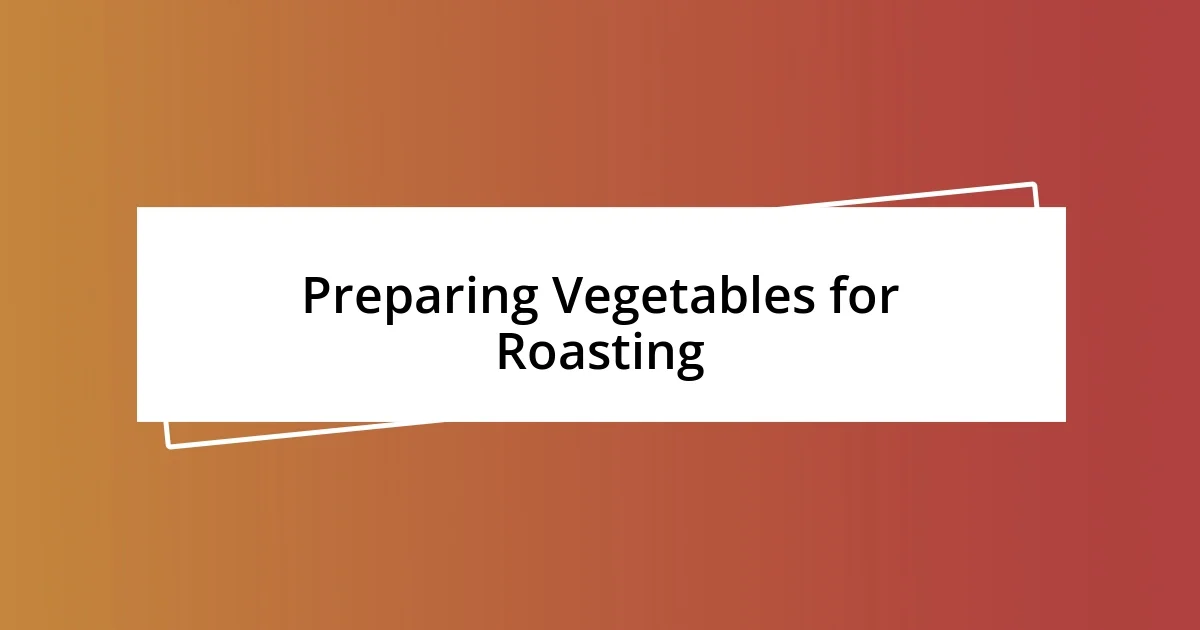Key takeaways:
- Select fresh, blemish-free vegetables and consider seasonal produce for the best flavor when roasting.
- Uniformly cut and properly prepare vegetables, including washing and seasoning, to ensure even cooking and improved taste.
- Store leftovers in clear glass containers, cool before refrigerating, and reheat in the oven to maintain crispiness.

Understanding Vegetable Selection
Selecting the right vegetables is crucial for roasting success. I remember a time when I grabbed a bunch of beautiful, vibrant carrots at the farmer’s market, only to discover they were too woody for roasting. Have you ever felt disappointed by the texture of your veggies after cooking? It’s all about understanding which varieties work best for the heat of the oven.
I’ve learned to look for firm, fresh vegetables with no blemishes. For instance, when I choose Brussels sprouts, I always opt for the smaller, tighter ones. They roast beautifully and pack a flavorful punch. It’s fascinating to consider how the size and freshness can impact the overall taste—have you ever experienced a roasted veggie that just didn’t hit the spot? It likely comes down to those initial selection choices.
Additionally, consider seasonal produce. I often find that when I roast vegetables that are in season, the flavors are brighter and more vibrant. In the fall, I gravitate towards squash and root vegetables, while summer calls for zucchini and bell peppers. Isn’t it a wonderful feeling to create a dish that celebrates what’s fresh and available? Each season offers unique tastes and textures, making every roasting adventure distinct.

Preparing Vegetables for Roasting
Once you’ve selected your vegetables, the next step is preparing them for roasting. This is where I’ve found the magic truly begins. I always wash them thoroughly, ensuring there’s no dirt or grit clinging to the surface—nothing spoils a delightful roast like an unexpected crunch! After washing, I like to slice them uniformly. This ensures even cooking; I remember the first time I roasted cauliflower florets of various sizes—some were perfect, while others were charred to oblivion. Lesson learned!
Here’s a quick checklist for preparing vegetables:
– Wash thoroughly to remove dirt.
– Peel where necessary—carrots and sweet potatoes often benefit from a good peel.
– Cut into uniform sizes for even roasting.
– Pat them dry to help achieve that perfect crispy exterior.
– Toss in olive oil and seasoning; I often use salt, pepper, and garlic powder for a kick!
In my experience, don’t shy away from adding herbs or spices before roasting. I recall a memorable dinner where I mixed rosemary with olive oil and drizzled it over my root vegetables. The aroma that filled my kitchen was intoxicating, leading to an equally delightful dining experience! Each time I roast, I remember that the preparation is just as integral to the final dish as the roasting itself.

Choosing the Right Oil
Choosing the right oil can make or break your roasted vegetable experience. I’ve experimented with various oils, and I’ve found that each one brings a unique flavor and texture to the dish. For instance, olive oil is my go-to for a classic taste, while avocado oil is fantastic for high heat and adds a delightful richness. Do you have a favorite oil for roasting? I bet it has its own story!
When I first started roasting vegetables, I used to think any oil would do. But I quickly learned that oils have different smoke points, which is the temperature at which they begin to burn and produce smoke. Canola oil, for instance, has a high smoke point and can handle the oven’s heat well, making it perfect for crispy veggies. In contrast, extra virgin olive oil has a lower smoke point, and while it offers tantalizing flavors, it can burn if exposed to too much heat. Have you ever tasted burnt oil? That bitter flavor can really take away from the goodness of your veggies.
I encourage you to experiment solely with oils until you find the perfect match for your palate. Once, I decided to baseline a batch of mixed vegetables using both sesame oil and coconut oil, filling my kitchen with a beautiful aroma. The difference in taste was striking! If you’ve ever put in the effort to blend unique oils, you understand the joy of discovering a new favorite. Here’s a handy comparison to help you decide on the right oil for your roasting adventures:
| Oil Type | Smoke Point | Flavor Profile |
|---|---|---|
| Extra Virgin Olive Oil | 375°F (190°C) | Fruity and grassy |
| Canola Oil | 400°F (204°C) | Mild and neutral |
| Avocado Oil | 520°F (271°C) | Rich and buttery |
| Sesame Oil | 410°F (210°C) | Nuts and earthy |
| Coconut Oil | 350°F (177°C) | Sweet and tropical |

Seasoning for Flavor Enhancement
Seasoning is truly the heart of flavorful roasted vegetables. I remember the first time I tried cumin on my carrots, and the transformation was incredible. The spices not only enhance the taste but create a warm, inviting aroma that fills the kitchen. Have you ever noticed how just a sprinkle of paprika or a dash of cayenne can elevate the entire dish? I find that experimenting with different blends keeps my meals exciting and my taste buds intrigued.
When seasoning, it’s all about balance. Too much salt can overshadow the natural sweetness of your vegetables, while too little can leave them tasting bland. I learned this lesson the hard way with a batch of Brussels sprouts that had about an ounce of salt instead of a sprinkle! Since then, I make sure to add my seasonings in stages. First, a light sprinkle before roasting, and then a final dusting just before serving to bring back that fresh flavor.
Fresh herbs are another excellent choice for adding depth. One glorious afternoon, I tossed roasted zucchini with fresh basil and a squeeze of lemon. The burst of fresh flavor made it feel like I was dining at a beautiful garden party! Which herbs do you find yourself reaching for? For me, a handful of thyme or some chopped parsley always seems to add that perfect finishing touch, making the dish not just tasty but visually appealing as well.

Roasting Techniques and Tips
Roasting vegetables can be an art form if you master a few key techniques. I remember the first time I used a baking stone; it was like opening a whole new world of flavor and texture. The stone retained heat so well that my roots turned perfectly crispy, while still being tender on the inside. Have you ever thought about the surface you roast on? It’s amazing how much of a difference that can make!
Temperature also plays a significant role in the outcome of your roast. I’ve discovered that roasting at a higher temperature – around 425°F (220°C) – helps caramelize the natural sugars in vegetables, creating that sought-after depth of flavor. When I first tried this method with sweet potatoes, the result was nothing short of blissful. It’s all about unlocking those hidden flavors! Have you given high-heat roasting a go?
Don’t forget to pay attention to how you cut your vegetables. I learned that uniformity is key; when I chopped my broccoli into different sizes, some pieces were perfectly roasted while others remained undercooked and unappealing. It was a lesson in the importance of even cuts. So, next time you’re prepping, give each piece the attention it deserves—trust me, your taste buds will thank you for it.

Testing for Doneness
When it comes to checking if your roasted vegetables are done, I often rely on two key indicators: texture and color. I remember the first time I poked a roasted carrot with a fork and felt that satisfying give. It’s a clear sign that it’s cooked through, yet still maintains that lovely bite—no mushy veggies for me! Have you ever experienced that delightful crunch right before it melts in your mouth?
I find that the visual aspect is just as crucial as the tactile. The vibrant colors of your vegetables should deepen and char slightly. Just last week, I pulled out a tray of roasted bell peppers that glistened with their caramelized edges. The sight was so enticing, it felt like they were calling out to be devoured! Noticing those golden flecks is a wonderful moment; it tells you that the sugars have caramelized beautifully, adding layers of flavor.
Lastly, taste testing is my secret weapon. When I’m unsure, I sneak a piece right off the baking sheet. I recall a time when I roasted some root vegetables for a family gathering and couldn’t resist picking at them before serving. The intense flavor of a fully roasted sweet potato made my heart sing! If you’ve ever had that moment of pure bliss from a perfectly roasted bite, you’ll understand why it’s my go-to method for determining doneness.

Storing Leftover Roasted Vegetables
When it comes to storing leftover roasted vegetables, I always opt for glass containers. Not only do they keep your veggies fresh, but they also allow you to see what you have at a glance. I remember one time, I stored some delicious roasted Brussels sprouts in an opaque container. By the time I rediscovered them a week later, they were a sad shadow of their flavorful selves. Have you ever had a similar experience? It really reinforced my choice to use clear storage.
I usually let my roasted vegetables cool to room temperature before placing them in the fridge. This helps prevent condensation, which can turn those vibrant, crispy bites into a soggy mess. Just last week, I put some perfectly roasted carrots into the fridge too soon out of excitement, and I regretted it when I found them mushy the next day. It’s a small step, but it makes all the difference!
When reheating, I recommend using the oven again if you can. It brings back that inviting crispiness that sometimes gets lost in the microwave. I can vividly recall reheating roasted cauliflower in the microwave, and while it was still tasty, it lacked that delightful crunch. If you have the time, pop them back into a hot oven for a few minutes—it’s worth it for those fantastic leftovers!














